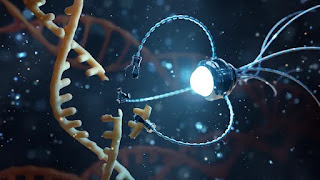Week 8 | Nanotech and Art | Maya Srinivasan
The topic for this week, nanotechnology and its relationship with art sparked many thoughts within me. Prior to this class, I had never really heard of nanotechnology nor understood its importance in many sectors of society. As mentioned during lecture, "the biggest market today is for nanoparticles," which is why understanding what they are and how they are used is so vital (Gimzewksi).
The CDC defines nanotechnology as "the manipulation of matter on a near-atomic scale to produce new structures, materials, and devices," specifically in engineered structures and devices (CDC). More specifically, it can aid in crucial advancements for solving environmental crises and particular health problems. Additionally, nanotechnology is rapidly growing as "the number of scientific publications in the field grew from about 200 in 1997 to more than 12,000 in 2002" (Brahic and Shanahan). This provides an exciting basis for future inventions and technologies based around this type of technology.
References:
BuzzfeedBlue. The World's Blackest Material - An Inside Look at Vantablack. YouTube, YouTube, 8 July 2016, https://www.youtube.com/watch?v=BkGHwrq2Eho. Accessed 18 May 2022.
CDC. “Nanotechnology.” Centers for Disease Control and Prevention, Centers for Disease Control and Prevention, 27 Mar. 2020, https://www.cdc.gov/niosh/topics/nanotech/default.html.
Gimzewksi, James. “Nanotech + Art .” 2022.
Irving, Bob, and Mike Pitkethly . “What Is Nanotechnology and What Can It Do?” AZoNano.com, 15 July 2013, https://www.azonano.com/article.aspx?ArticleID=1134.
Moore, Sarah. “Nanotechnology in the United Kingdom Market Report.” AZoNano.com, 10 Jan. 2020, https://www.azonano.com/article.aspx?ArticleID=5385.
O'Brien, Nathan. “Nanotechnology and Nanomaterials; Where Science Meets Art.” Nano News, 18 Apr. 2017, https://blogs.flinders.edu.au/nano-news/2017/04/18/nanotechnology-and-nanomaterials-where-science-meets-art/.
Port, Jake. “From the Vault: Vantablack, the Blackest Material Ever Made.” Cosmos, 4 May 2021, https://cosmosmagazine.com/technology/materials/understanding-vantablack-the-blackest-material-ever-made/.
Release, Media. “Art Meets Nanotechnology Meets the Apocalypse - Westender - West End 4101.” Westender, 21 Apr. 2017, https://westender.com.au/art-meets-nanotechnology-meets-apocalypse/.





Hey Maya. This week’s topic was nanotechnology and I was excited to see what others thought about it. I had no idea whatsoever that nanotechnology was growing at the rate it is; I’m both shocked and excited given the endless possibilities. I noticed that you mentioned Vanta black and black 2.0 in the latter half of your post, which happens to be the focus of my own blog post this week. I’m glad to see the “great minds think alike” phrase in action. I am curious though; what color did you prefer between the two: the more expensive, carefully created version (i.e. Vanta) or the more accessible, affordable one (i.e. Black 2.0)? Thank you for your post!
ReplyDeleteGreat post and recent citations! I have a few reactions to some of your statements. I'm amazed that I (and probably most of us) have known so little about nanoparticles when, as you noted from the CDC, they are the biggest products on the market. The exponential growth of publications in the five year span that you noted is outstanding! (I'm curious if you know of the number of publications today?) Thanks for sharing with us the creation narrative of an extreme black; this product is not just important for curiosity sake, but to read of other innovators attempting to make this available to the general public highlights the passion of artists in general education. Do you think that the general public will care about the distinction between the two blacks, or is anything above 99% suitable?
ReplyDelete